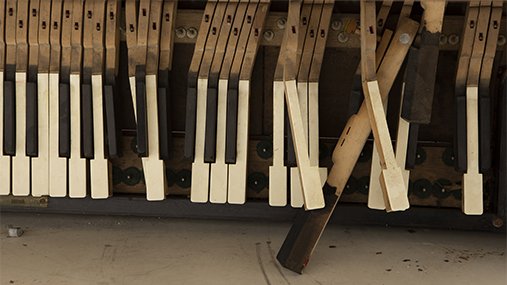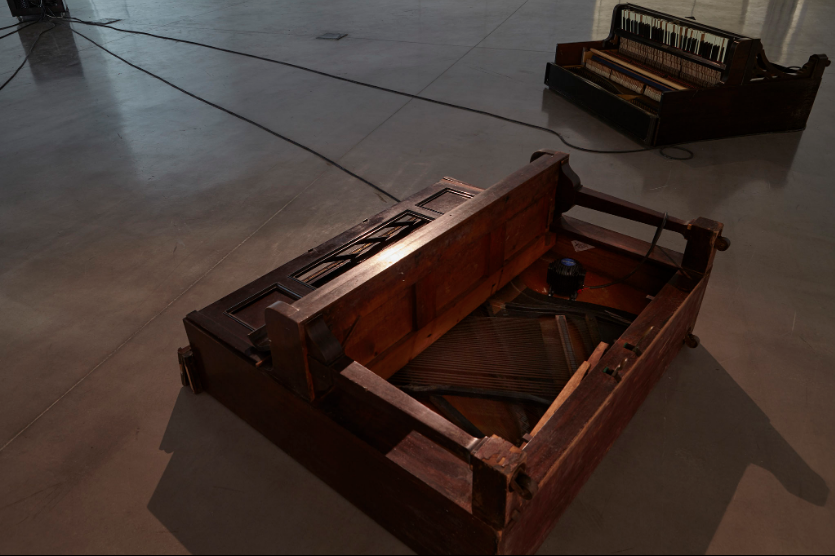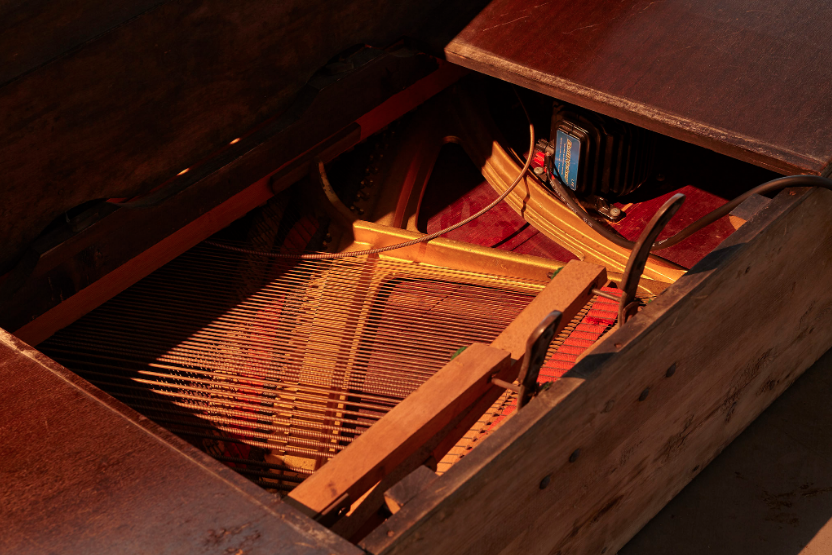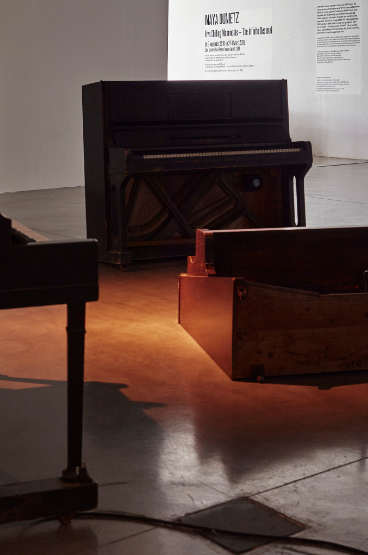Photo by Dor Even Chen
Five Chilling Mammoths
Five Chilling Mammoths (2015-ongoing) is an installation of a family of five retired pianos, gathered from different corners of the world. Each family member is an individual within the collective. These large, broken, and damaged beasts who have already shed their function and identity, had been drilled with buttkickers that allow them to resonate, ululate, roar, and hum in a new way. Their song resonates their relationships. They shift in and out in a futile effort to reach some impossible middle ground. The song has no Major or Minor, but rather it embodies their infinite search for a point of equilibrium. In this universe of beats, five chilling mammoths reminds us that sound is the movement of matter, be it string, wood, flesh, or air. Since 2017, this family of mammoths has been traveling the world to sing their ever changing song.
Five Chilling Mammoths at The Artists Residence, Herzliya
Five Chilling Mammoths at Loving Art Festival, Jaffa
The Artists Residence, Herzliya
Pianos are solitary creatures, usually found standing alone in living rooms, rehearsal halls, studios, and on auditorium stages. These massive, wondrous, yet tamed beasts can be controlled with the tip of a finger. However, as they age and their body expands and cracks, their screws loosen and their strings detune, they become feral. What would happen if they were set free in the wild? What other sounds do they hold within, beyond their measured, familiar gestures, which have come to define them?
Sound artist Maya Dunietz, savior and saint of retired pianos, decided to explore the feral sounds of pianos. She established a family of five retired pianos, gathered from different corners of the world. Each family member is an individual of unique characteristics within the collective. These large, broken, and damaged beasts have already shed their function and identity. As their voice no longer depends on a hammer striking a string, they distance themselves from the standard and favor the potential inherent in change.
Curious to find out what sounds they would make, Dunietz hybridized the pianos with low-frequency transducers. These transducers, or “buttkickers”, are essentially large magnets drilled into the pianos, pushing and pulling their heavy bodies thus inspiring them to roar, hum, and tremble. The magnets receive digital signals composed by Dunietz through a unique algorithmic system that sound designer Daniel Meir, her project partner. These signals, amplified through the transducers, interact with the pianos and become audible, while spreading through the pianos into the room, reverberating between the walls and other objects, continually adding sound layers. Within this process, previously unheard sounds appear, sounds that you wouldn’t expect from a piano.
The entire group of pianos shifts from unity to complexity, from organization to anarchy. The usual rules can no longer contain them, and they have sloughed off the system of power that created them for its own use. The power of reason cannot withstand a tidal wave of passion. Emancipated from the constraints of the equal temperament’s regime and normative order, the pianos are also released from the tyranny of the normal. They are unusual, deviants, fluid, unpopular. They are stray weeds outside the system. Their flaws are no longer a dead end, but rather constitute raw materials. Instruments that can be used to pave a new path.
The sounds produced by the pianos are free of standard tonal ranges. The notes seem to cry out without hierarchy or fixed focus. With no comforting, familiar framework to provide a foothold, the music is throbbing through large, weary wooden bodies. The pianos growl, roar, purr, squeak, and whistle. Their song resonates the relationships between them. They shift in and out in a futile effort to reach some impossible middle ground. The song has no Major or Minor, but rather it embodies their infinite search for a point of equilibrium. In this universe of beats, five chilling mammoths reminds us that sound is the movement of matter, be it string, wood, flesh, or air.
The first encounter with the piano's song may seem threatening to someone unused to be freed from twelve regimented half-tones. They may produce an uncontrolled tremor in the body. However, if we let go, as have the pianos, we too could be swept by their dynamics, regulate our pulses with theirs, becoming part of their movement. This movement is vibration, a force of nature that we hear, feel, and touch with our bodies. As our body reacts to this tangible vibration, it creates music of powerful nuance and frequency. This is a reminder that our sense of hearing is produced by bone conduction. And even dry bones can sing.
By Ran Kasmy Ilan







Composition: Maya Dunietz and Daniel Meir
Hybridization: David Lemoine
Linguistic consultation: Noa Shuval
Mathematical consultation: Dr. Liat Even-Dar Mandel and Assaf Talmudi
Linguistic editing: Assaf Shur
Curator: Ran Kasmy Ilan
Mammoths on the Boulevard





Curator: Amnon Ron
The Infinite Decimal GMEM Festival, FracPaca museum
Five ancient, huge beasts sprawled in the gallery space like relics from a prehistoric age, whose thunderous, raging and tremulous sounds resonate from the body of the pianos. This musical family creates a savannah of notes that play off one another in a desperate attempt to find a meeting point, despite the fact that it is in constant motion and thus perpetually escapes them.
The piano family members interact with one another in a dance of ongoing tension, the frequencies they sing are constantly moving towards or away from each other.
In Maya’s own words: “The piano is a compromise. It tells a lie. Going to the piano to compose, I find that even a simple middle point such as the middle of an octave is, in fact, an unreachable, irrational place. While historically, the Equal Temperament was invented to allow keyboard instruments to play the same melodies in different keys, it resulted in accidentally creating a new approach to music that seems to me rather flat, ignoring the subtleties of a single pitch in a specific melodic and tonic context, blurring the specific pitch’s specific deep intention. Wearing this candy disguise, the piano’s 88 notes can pretend to be any creature in the world. As a response, I created my own pianos - these are broken and ruined pianos that were revitalized and reborn as hybrids of old and new technologies. They look like one thing and sound like another. They sing with their warm vibrations a song of the infinite decimal.
All the sound that is generated and then sent to the pianos is simply a pure sine wave. When this sine wave meets the piano and the room, magical things occur; we start to hear beatings, worlds of harmonics, chords and rhythms inside the note being sent to the piano. It may sound like other instruments, but it really is just a pure sine wave. I recommend to move around in various directions, and attach an ear on the wood of the piano to experience the many psychoacoustical dimensions of the space.”





Composition: Maya Dunietz and Daniel Meir
Artistic concept development: David Lemoine
Lights: Nimrod Getter
Fragrance creation: Gip - Grasse Institute of Perfumery
Producer: Diana Shoef
Curator: Pascal Neveux
Mammoths on the Roof
Courtesy of Mekudeshet Festival 2018
Curators: Yehudit Shlosberg Yogev and Itzhak Mizrahi

